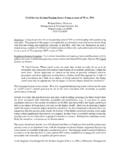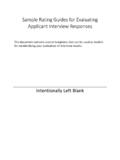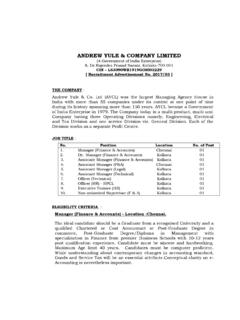Transcription of THE GENERAL MANAGEMENT IN-BASKET (GMIB) …
1 This report is an update of earlier papers on the GENERAL MANAGEMENT IN-BASKET , including:* The item-by-item scored GENERAL MANAGEMENT IN-BASKET , International Personnel ManagementAssociation Assessment Council, Philadelphia, PA, 1987.* The GENERAL MANAGEMENT IN-BASKET , 19th International Congress on the Assessment Center Method,Toronto, Canada, GENERAL MANAGEMENT IN-BASKET (GMIB)Technical ReportRichard C. JoinesSeptember 2011 MANAGEMENT & PERSONNEL SYSTEMS, CREEK, CA 945951-925-932-0203 Buros Mental Measurements Yearbook12th Edition, 1995 Reviewer #1In summary , the GENERAL MANAGEMENT IN-BASKET is a sound test ofmanagement results will be informative to the candidates, andtheir acceptance of the test should be "Reviewer #2"In comparison to assessment centers, the GMIB provides a similar level ofvalidity at significantly lower In short, the GMIB should be seriouslyexamined by any organization interested in improving the identification andselection of its MANAGEMENT "The GENERAL MANAGEMENT IN-BASKET (GMIB)The GENERAL MANAGEMENT IN-BASKET is the only IN-BASKET test that has been reviewed for Buros'Mental Measurements Yearbook.
2 The GMIB was included in the 12th edition, published keeping with standard practice, two experts in the field independently reviewed the GMIB. Excerpts of their reviews are given FOR STUDENTSIn addition to the full GMIB test, a short form of the GMIB has been in usage for many years. In2007, a new version of the GMIB Short Form was developed for students. It is known as theMSAT (Managerial Skills Assessment Test). The MSAT was implemented by one of the top tenbusiness schools in the country and is now used as part of their educational curriculum for allbusiness school students. As of 2011, over 5000 students have been tested. The MSAT is used todiagnose the student s current ability to lead and manage people. Each student is given a PersonalManagerial Development Report.
3 In addition, courses have been redesigned to provide coverage ofthe managerial concepts embedded in the & PERSONNEL SYSTEMS, CREEK, CA 94595 Page 1 THE GENERAL MANAGEMENT IN-BASKETO verviewThe GMIB was developed by the author in 1984. The first paper on the GMIB was presented at the1987 International Personnel MANAGEMENT Association Assessment Council. This paper gave ananalysis of problems associated with the scoring of the traditional IN-BASKET , along with how theseproblems were solved by utilizing the GMIB item-by-item scoring methodology. Additional papersdescribing reliability and validity studies were presented at the 1989 and 1991 meetings of theInternational Congress on the Assessment Center report is essentially a combination of the earlier papers, along with the results of additional studiesthat have been conducted.
4 The first major validity study on the GMIB was conducted in 1987. Theresearch method utilized in that study, along with the results, is described in detail in this studies of the GMIB utilized essentially the same methodology, with the exception of astudy conducted by the Department of Army. The results of these additional studies are brieflysummarized in this information on the performance of racial and sex groups is also available at this time andis described in this report. Finally, information pertaining to the relationship of the GMIB to otherassessment instruments is the time of its development, the GMIB represented a significant departure from traditional in-baskettechnology. The approaches used in developing and scoring the GMIB were not based on anypreviously described methods or work (published or unpublished).
5 The GMIB approach was original,designed specifically to overcome the more serious problems associated with IN-BASKET testing: namely,problems related to time and difficulty of scoring, and scoring additional problem associated with the traditional approach, especially as used in the public sector,was the practice of emphasizing face validity in the IN-BASKET scenario and items. The rationale for thisapproach pertained to concerns for content validity. Prior to the GMIB, in-baskets used in the publicsector were typically developed for a specific position, with face validity maximized; and consequently,such in-baskets were only appropriate for the one position for which they were GMIB departs from the approach of emphasizing face validity in the IN-BASKET scenario and GMIB places candidates in a neutral scenario and achieves content validity that generalizes acrossorganizations and different MANAGEMENT assignments.
6 This was accomplished by constructing in-basketitems that would be relevant across virtually all MANAGEMENT jobs. A twofold strategy was used: (1)the GMIB was designed to be a "theory-based" IN-BASKET , with many items oriented towards testing thePage 2application of MANAGEMENT theory to practice; and (2) common MANAGEMENT situations that generalizeacross MANAGEMENT positions were identified and items constructed to sample these departing from traditional IN-BASKET testing in significant ways, the GMIB nevertheless retainsthe key features of traditional IN-BASKET testing that have generally been regarded as unique, valuablefeatures of the IN-BASKET testing format. Principal among these features is the requirement forcandidates to formulate their own courses of action in response to the IN-BASKET items, and write memosand letters as appropriate.
7 Thus, the GMIB has not overcome traditional IN-BASKET problems by merelysubstituting a closed-end (or multiple-choice) response format. Rather, the GMIB has overcometraditional IN-BASKET problems by implementing a number of important changes that, when integrated,achieve the desired goals of greatly reduced scoring time, high reliability of scoring, and contentvalidity that generalizes across different organizations and MANAGEMENT utility of the GMIB approach has been demonstrated in a number of studies to be described in thisreport. These studies demonstrate that: (a) the inter-rater reliability of scoring the GMIB is typicallyon the order of .90 or higher; (b) the GMIB possesses significant, substantial criterion-related validityin predicting managerial success across different occupational groups; and (c) the GMIB has lessadverse impact than reported in the literature for ability and achievement following are key innovations introduced by the GMIB:!
8 Theory-based model used for development of leadership, employee motivation, morale andempowerment items, including theories pertaining to participative leadership, motivation-hygiene (intrinsic vs extrinsic job satisfaction factors), and situational leadership!Items developed to be relevant across organizations, different MANAGEMENT jobs, differentassignments, and level of supervision!All power items; no simplistic "throw-away" items; traditional in-baskets frequently includeditems such as magazine articles that should be read when time allowed and/or routed to othersand/or other simplistic items that did not involve any substantive knowledge or skill area thatwarranted independent measurement!Separate answer forms, thus no need to review test pages for notes; one answer form designedto capture candidate's actions and understanding of MANAGEMENT issues presented by the item,another answer form for use in writing memos and letters!
9 Elimination of IN-BASKET features and scoring methods that are readily susceptible to training orcoaching; "problem analysis" is not scored by observing whether candidates "tie" items together;"planning & organizing" is not scored by observing whether candidates prioritize or handle themore important items first, or whether candidates spend time dealing with "throw-away" itemsPage 3!Items scored independently on 0-4 or 0-5 basis; critical items scored on five point scale with onepoint allotted to candidates who fully attempt the item, regardless of item response (introducedas a means of indirectly measuring "planning & organizing" skill)!Total score arrived at by simply summing item scores, , no need to try to relate informationto dimensions to arrive at IN-BASKET total score!Only one rater required due to extremely high inter-rater reliability resulting from new scoringapproach (second rater does not add significantly to scoring reliability due to high single raterreliability)!
10 Factor analysis results used to derive "dimension" scores; the four factors measured by theGMIB are (1) Leadership Style and Practices; (2) Handling Priorities and Sensitive Situations;(3) Managing Conflict; and (4) Organizational Practices/ MANAGEMENT Control!Automated, yet individually tailored candidate feedback reports with suggested developmentalneeds and learning objectives for each of the four factors measured; additionally, reports includefeedback on speed of processing administrative work based on number of items completed (afeature not included in traditional in-baskets)In addition to the standard public and private sector executive versions of the GMIB, forms are alsoavailable for all Public Safety supervisory level positions (Police Sergeant through Chief; and FireCaptain through Chief).







